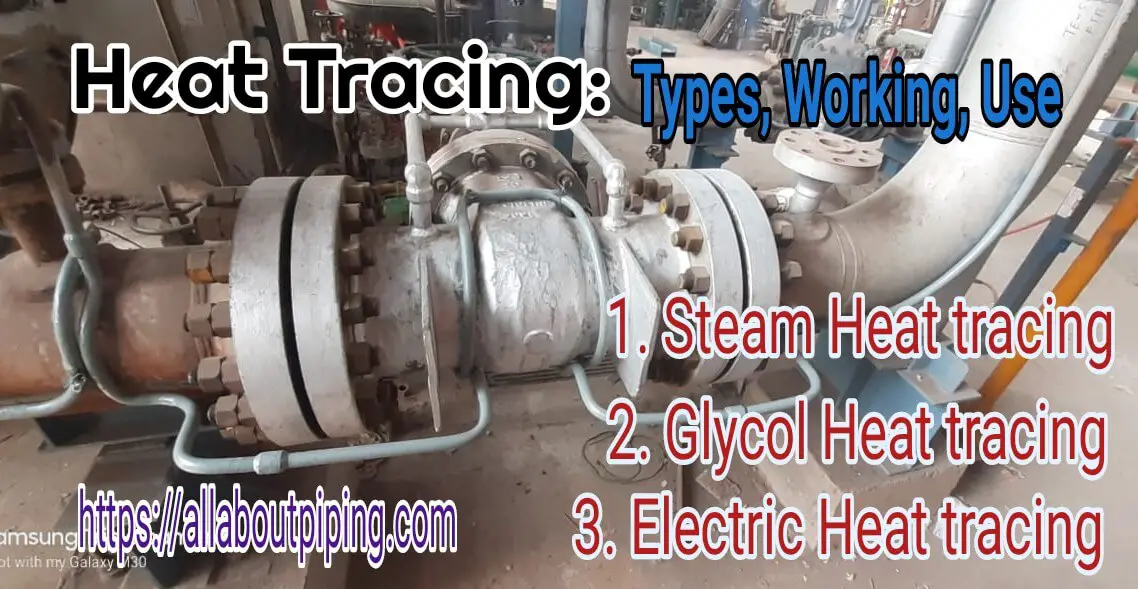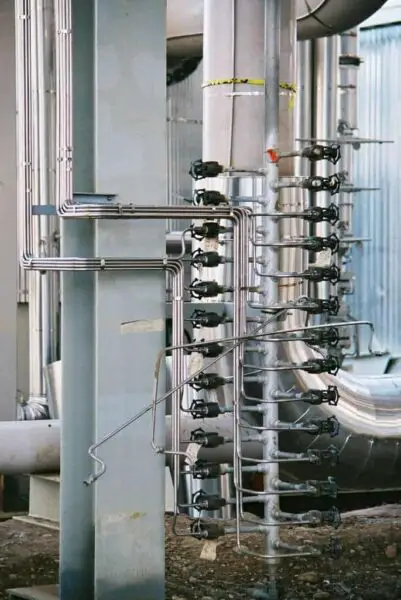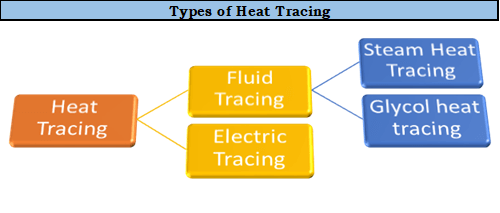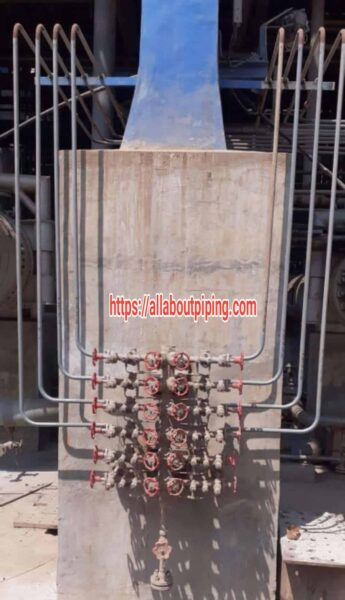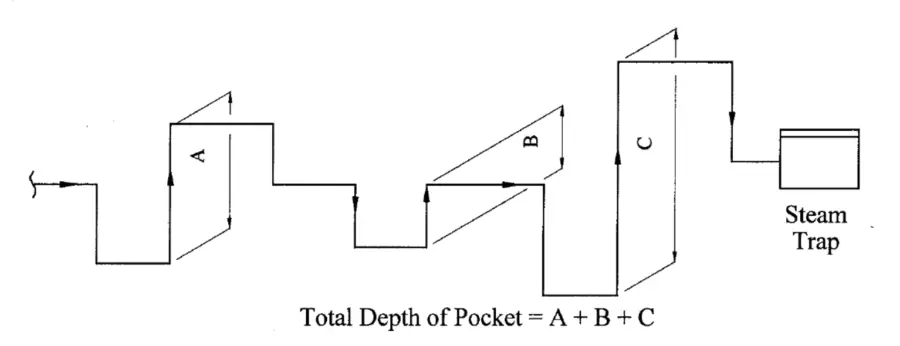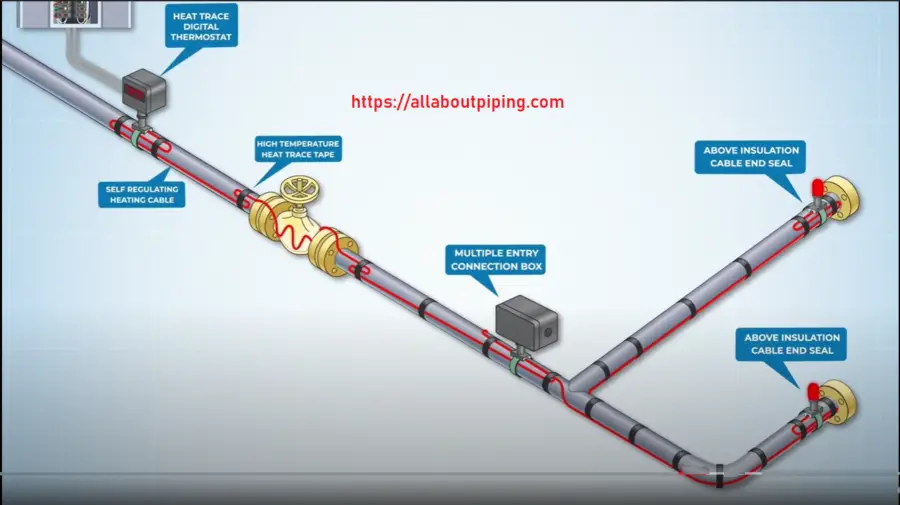Heat tracing in Piping is a generalized term for radiant heat transfer into the Piping system. Either from tubing or electrical wire heat is being transferred from the heat tracing system to the main process piping system to maintain the required temperature of the fluid in the pipe.
Heat in Piping is also contained with help of Insulation but this is not a full-proof method of maintaining the temperature of fluid flowing in Piping. So, to make up heat loss during the transportation of fluid from one point to another heat tracing is introduced in the piping system.
In this article, if Heat tracing we will give you a detailed description about:
- What is heat tracing and why it is used for piping?
- Type of Heat tracing?
- Advantages and Disadvantages of each type of Heat tracing method.
- Glycol heat tracing method.
- Comparison among different types of heat tracing methods.
More to Read: What Is RF Pad? How To Calculate Reinforcement pad dimensions?
Table of Contents
What is Heat Tracing?
Heat tracing is a freeze protection method used in piping to regulate the required temperature of the Piping network for an undisturbed flow of fluid in pipes. Heat tracing is a vital process for any piping system inside pipe insulation that helps the piping network to achieve freeze protection.
In General, Heat tracing is a set of a system along with Pipes and vessels. This path has the capacity to increase or maintain the temperature of fluid flowing in the main piping network. steam tracing in oil and gas is a well-versed method to reduce the viscosity of the fluid in case of low temperature.
The heat tracer used for heat tracing is normally maintained temperature with the help of steam or an electrical power supply to radiate heat to the main pipe.
Importance and Need of Heat Tracing in Piping
Need of Heat tracing in the oil and gas industry is necessary according to outside environmental temperature or piping network with cold conditions where fluid flowing within pipes are can freeze issues which can create hurdles for flowability and develop a crack in the main pipe body. A heat tracer eliminates that threat of freezing by raising the temperature in the piping network.
In absence of a Heat tracing system a piping network operation can result in:
- Frozen pipes and equipment
- Blocked pipes
- Production loss
- The plant shut down and Repair work
- Pipe damages
To avoid any of these above-mentioned conditions piping heat tracing is required in two conditions:
- Surrounding temperature of Pipe is Low or,
- A pipe carries a high viscous fluid
Heat tracing serves many purposes for a piping network for its protection like:
- Freezing protection
- Maintaining the required temperature.
- Maintaining required fluid viscosity for flowability in pipes.
- Prevention from Snow or Icing of lines.
Types of Heat Tracing in Piping
Heat tracing system majorly divided into two types:
- Electric heat Tracing and
- Fluid heat tracing
Where electric heat tracing develops heat with help of electricity and electrical heat tracing wire, fluid heat tracing usually contains a tube or a small diameter pipe (usually 0.5″ ) in which steam is transmitted as media to generate heat. The heating of tracing fluid can be provided by waste heat from process steam, burning of fuels, or electricity.
Fluid heat tracing is further divided into two types:
- Steam Heat tracing
- Glycol heat tracing
While Steam heat tracing uses steam as a medium of heating, Glycol heat tracing uses heated glycol as a medium.
Featured Post: What is Triple Offset Butterfly Valve? Definition, Design, Application, Code, and standard
What is steam Heat tracing?
Steam tracing is a method of heat transfer to pipe with help of tubes in which steam with high temperature and pressure-flow alongside piping network to maintain temperature. A steam tracing system consists of:
- Tracer Pipe and fittings: For steam flow
- Steam manifold: For operation and steam distribution on different piping networks
- Steam control valves: For controlling steam pressure and temperature
- Steam traps: For separation of steam from condensate and draining out.
Definition of Steam Tracing Terms
There are many terms that need to know while installing or operating with a steam tracing system.
- Heat Tracer: Tube containing steam for radiant heat transfer to main process pipe.
- Heated Pipe: The main pipe which considered to receive heat from the heat tracer.
- Air Convection Tracing: Transfer of heat by means of air convection in the annular space between thermal insulation and heated pipe.
- Ambient Temperature: It is the temperature of the surrounding atmosphere.
- Condensate: Water formed in the tracer when latent heat is given to heat pipes or equipment.
- Condensate Header: The mainline for collecting and distributing condensate.
- Steam header: Mainline or mother line for steam distribution.
- Conduction Tracing: This is the tracer tube bounded to the main pipe which being heated through steam tracing.
- Dry Steam: Steam with no moisture contents.
- Heat Loss: The rate of heat loss from a process pipe to the environment through pipe insulation.
- Heat Sink: A surface of the Piping system such as a flange or valve which is at a lower temperature than the main process piping network.
- Heat Transfer cement or heat transfer compound: In heat tracing piping, a heat conductive material with high thermal characteristics is used.
- Heat media: Heat transfer fluid that flows through a tracer tube network.
- Heat up: A process where main process piping or equipment requires the additional raise to heat.
- Pockets or closed loops: Bends or dips in the tracer where condensate can collect.
- Process maintenance temperature: The minimum temperature required to hold process pipe or equipment to keep the contents from freezing.
- Steam and condensate manifold: Modular prefabricated steam supply and condensate collection units that are designed specifically for steam tracing circuits.
- Steam Trap: Automatic device used to hold steam in a steam tracing circuit until it has given up its latent heat and allows condensate, air, and other gases to pass while preventing the passage of steam.
Steam Heat tracing installation
Generally, Site fabricated bends are being used in place of forged elbows except near steam supply and condensate return manifolds. Steam manifolds with inbuilt glandless piton valves are generally used for steam distribution.
Installation of Steam Supply Subheader: The layout of the steam supply subheader and supply manifold should be arranged to minimize the length of steam supply tracers. Each subheader should be equipped with a glandless piston valve and a Y-type strainer as per applicable size should be provided.
Steam Supply Manifold: In general practice, the Location of manifolds is planned to minimize the length of the tracer. When 03 or more tracer are provided manifold is required for steam distribution.
Steam Tracer Size and Quantity: Generally, Steam tracers of 0.5″ dia are used for heat tracing. The number of tracers required for the Main process line is as follows:
- For 4″ NB and smaller: 01 No. of Tracer
- From 6″ NB to 16″ NB: 02 No. of Tracer
- From 18″ NB and Above: 03 No. of tracer
Details Installation of tracer are as follows:
- The tracers should be held in position by galvanized iron wire spaced every one meter.
- As per specification and requirement heat transfer cement for steam tracing should be applied on bare tracer for positing.
- Wherever there is a requirement of a single tracer in the plant Area, an individual supply lead line can be directly tapped from the nearby steam header/ subheader and routed along the line to be traced.
- The tracers shall start at the highest point in a system in general. As far as possible tracers shall be routed with a continuous slope towards the trap.
- Total pocket depth of pocket shall not exceed the specified depth as per the requirement.
- Each tracer to paired equipment and instruments to be provided with isolation valves
- Tracer should not be provided with low point drains.
- The tracers should be laid so as not to interfere with the normal working, operation, and maintenance of plant machinery.
- Wherever the traced piping is having flanged connections and traced piping needs to be disconnected for frequent maintenance, flushing, etc., break flanges at suitable locations should be provided on tracers.
- All flange connections provided on tracers should be located outside the insulation.
- The installation should be done to take care that the valves and steam traps on supply and return manifolds are easily approachable.
- The steam supply lead lines should be routed together, as far as possible. In the case of several tracers routed together, the spacing between individual tracers may be reduced to allow box-type insulation.
- The tracers should be anchored at the middle point of the tracer run and adequate free space
How does steam tracing work?
After the steam heat tracing installation along with the main process piping network steam from the header is distributed through a steam manifold to all steam tracers. As per the requirement High-pressure steam, Medium Pressure steam, or Low-Pressure steam flow through steam tracing piping network.
Latent heat of steam is soaked by process pipe through radiant heat transfer and condensate is collected with help of Steam trap.
In few words, Steam from a boiler to the steam header and finally to steam tracer through steam manifold losses its latent heat to process pipe via radiant heat transfer. This is how does steam heat tracing works.
Advantages of Steam tracing
When we already know from the upper part of this article about what is steam tracing in oil and gas piping or piping related to any industry. We need to know some of the advantages of steam tracing that makes this widely used in Piping are:
- With a plant with Boiler, getting steam is easy for steam tracers. So, operational cost is also low.
- Maintenance of Steam tracing system will cost low price.
- Steam tracing of Process piping is highly efficient comparatively with some heat loss because of radiant heat transfer.
- Gaining the required temperature with steam is easy, quick, and effective.
- No pumping is required for steam distribution in tracers.
- Highly effective temperature control.
- The distribution of steam to different process pipes can be easily controlled with help of a steam manifold.
- Comparatively greater temperature range can be achieved with steam tracing.
- A considerable amount of heat produced with steam tracing can be reused in boilers which saves cost and make it more efficient.
- Condensate-produced steam can be reused in boilers. That creates a reusable resource.
Disadvantages of Steam tracing
With a lot and different types of steam tracing benefits there is also disadvantages of steam tracing as follows:
- Installation of steam tracers is comparatively required more manpower and costing.
- The operational cost of steam tracing is quite more with an Industrial facility without a boiler. As they have to spend more on the installation of the boiler too.
- Requires more routine check-ups and maintenance.
- Not so efficient when heat loss becomes a factor to judge its effectiveness because of radiant heat transfer.
- With a short distance of operation steam tracing is best but for long-distance it losses its effectiveness.
- The heat distribution of steam heat tracing is not uniform.
- Bare tracers are not effective hence insulation is required for containing heat produced.
How to calculate pocket depth for steam heat tracing?
Pocket depth is the distance of the tracer pipe in the direction of flow from the lowest point to the highest point. The total pocket depth is the sum of all risers of the tracer. The maximum tracer total pocket depth should be equal to 40% of the tracing system gauge press range in meters.
Electrical Heat tracing basics
Electrical Heat tracing is a type of heat tracing in piping where an electrical element is used to transfer heat from the heat tracer to the main process pipe. Here heat is normally generated because of the resistive nature of the heat tracing cable.
An electrical heat tracing system is much more than just a normal heating cable. Most of the commercial electrical heat tracing systems are of resistive type. Electrical heat tracing basics are based on Ohm’s Law.
When an electric current is flowing through the resistive element of the electrical heat tracer, heat is produced. As per Ohm’s Law:
V= I * R and
Heat Output= I² * R
Where I= Amount of current flowing
R= Resistance produced
V= Applied voltage
Here in the case of Electrical heat resistance, Power dissipates in the form of thermal energy, i.e. HEAT
Electrical Heat Tracing Terms
Terms frequently used for electrical heat tracing are as follows:
- Heating cable or Tracer: This is the resistive element that generates heat.
- Pipe Straps: Theses are used to hold an Electrical heat tracer with a pipe in its position.
- Power Connection box: This is the power input device to the tracer
- Junction Box: This is a distribution box from where multiple cables can be distributed for different branches of the piping network.
- Cable Tray: Component of electrical heat tracing system that helps to support, make space, and route for tracer traveling apart from pipes.
- RTD or Resistance Temperature detector: This is an electronic device that measures the heat produced by a tracer by measuring the resistance of the tracer.
- Heat Tape: This is just like tape made of cloth which sustains itself with high temperature. Installing a heat tape with tracer supports tracer with main process pipe.
- End Seal: When tracer with piping network a cap with an electrically conductive solution is capped to this that makes a circuit complete.
- Thermostat or Controller: The device which helps to maintain a certain required temperature for a process piping network.
- Terminator: Cable connected through JB or Power connection box with help of gland is called the terminator.
How electrical Tracing works?
Electric heat tracing usually uses one or more cables as per the requirement to provide the heat flow from all directions. Using more than one cable is a more reliable configuration since heating can be continued if one of the cables will get damaged. This configuration will provide time for maintenance to perform the required preparations.
In the electric heat tracing method transfer of heat to the process pipe is done as per radiation method heat transfer but heat tracer is closely compact with
Modern electric heat tracing with regulating heating cable often has a self-regulating design, that adjusts the heat output as needed. Conductive elements are embedded in a polymer that expands and contracts in response to temperature and provides heat regulation to process pipe.
- When temperature drops and polymer contracts, more conductive pathways are formed and resistance gets decreases. Current through the heat tracer cable increases and more heat is released.
- In the opposite process, When temperature increases the poly expands, and conductive elements separate, and as result resistance increases. This decreases the flow of current in the tracer and less heat produced as a result.
An electrical Heat tracing system can also be equipped with a control and monitoring system to allow pre-programmed heating sequence, alarms, and other notifications.
Heat Tracing Cable Classification
Heat tracing cable is selected based upon:
- The circuit length Requirement
- Operating temperature application
The combination of these two factors will determine which type of cable will be most suitable for a process piping network to fulfill its heating requirement. There are three types of Electric heat tracing cable:
- Self-Regulating Polymer Jacket cables are normally used for temperatures up to 200 ºC and circuits of length up to 750 ft.
- Mineral Insulated cable Suitable for temperature up to 650 ºC and a total circuit length of 3300 ft.
- Skin effect heating cable systems are intended for application with a much longer heating circuit that can reach up to 82000 ft and can typically generate temperature up to 250 ºC.
Parameter to select Heat tracing cable for Piping
For each type process pipe heating process there is a different variable that needs to look for when the selection of heat tracing cable is done. The heat tracing cable selection parameter is as follows:
- Heat requirement.
- Ambient temperature.
- Pipe Material.
- Maximum Exposure and Maintenance temperature.
- Tolerance on supply voltage and voltage drop on feeding cables
- Service voltage.
- Area Classification.
- Chemical Environment.
- Design Margin.
Piping Heat Tracing Tape or heat tape
- Heat tapes look like electrical extension cords which are specifically designed to produce heat when electricity is passed through them. An industrial heat tracing tape should possess the following characteristics:
- Heat tracing tapes should flexible to easily wrap around the pipe or equipment.
- Heating tapes should provide very close contact with the pipe material for higher efficiency of heat transfer.
- Heat tracing tapes should be fast in heating.
- Heating Tapes should able to withstand higher required temperatures.
- Heat tracing tapes or heat tracing cables must be durable and long-lasting
For efficient output and heat tape working following points should be followed during installation of heat tape:
- Heat tape should not overlap during installation.
- The surface should be well cleaned before the application of heat tape to the pipe.
- For valve, flange, and other heat sink areas Extra length of heat tracing tape should be provided.
Advantages of Electrical tracing
The advantages of Electrical heat tracing are as follows:
- As electrical Heat tracing uses the conduction method of heat transfer, but binding to the pipe is too compact because of which loss is heat is too less respectively.
- Electric heat system offers more variety of temperature range.
- This can be controlled remotely.
- Easy to install and replace during maintenance.
- Energy-efficient.
Disadvantages of Electrical tracing
- Higher cost of maintenance.
- Heat effectiveness decreases with the length of the tracer
- Not safe to install where flammable substances are present.
- If monitored carefully, System can be overheated and create damage.
- Multiple tracers required to ensure any system failure.
What is Glycol heat tracing?
Glycol is having an anti-freezing property that is used for the glycol heat trace system. When glycol is added to water this lowers the freezing temperature of the fluid contained in the pipe result to melt it down and clearing the flowing path.
Glycol heating system is also known as hydronic heating because of mixing of water to glycol to produce an anti-freezing effect. Tube or Tracer of glycol heat trace system has the same installation method as steam heat tracing.
The water mixing ratio has an important role in its efficiency. The maximum recommendation of glycol to water mixing is 1:2. A glycol concentration lower than 50% avoids overtaxing the performance of the system’s boilers and pumps while eliminating the risk of damage occurring in low-temperature climates.
Steam tracing vs Electrical tracing
Comparison between Steam Tracing and electrical tracing is as tabulated:
Difference between electric heat tracing and steam heat tracing
| SL. No. | Parameters | Steam Heat Tracing | Electric Heat Tracing |
|---|---|---|---|
| 01 | Installation method | Comparetively High Skill Required | Comperatively Low Skill Required |
| 02 | Installation Cost | Higher with Pre-installed Boiler facilty | Comparetivly low |
| 03 | Operation Cost | Low | High |
| 04 | Maintenance Cost | Low | High |
| 05 | Temperature range | upto 400 Degree Celcious | Upto 250 Degree Celcious |
| 06 | Heat Loss | Comparetively High | Comparetively Low |
| 07 | Method of Heat Transfer | Radiation | Radiation |
| 08 | Auto control | No | Yes |
Conclusion
Heat tracing is a method that maintains the temperature and flowability of fluid contained in the pipe. Heat tracer is an important part of heat tracing system it can in either form of wire or tube that generates heat to main process pipe. Heat tracing method and type can be summarised as:
- Heat tracing is of two types: a. Fluid type and b. Electrical type.
- Heat tracing is an important part of piping. Especially in places where the environmental temperature is low or fluid flowing through pipe have high viscosity.
- Heat tracing is done for freezing protection and decreasing/eliminate maintenance work because of the blockage of pipes.
- In steam heat tracing latent heat of steam is passed to the main process pipe through the radiation method of heat transfer.
- In electric heat tracing heat produced because of the resistive nature of the tracer transferred to the main process pipe through the conduction method.
- Glycol heat tracing uses glycol as a de-freezing agent to lower the freezing temperature of the fluid contained in the pipe.
